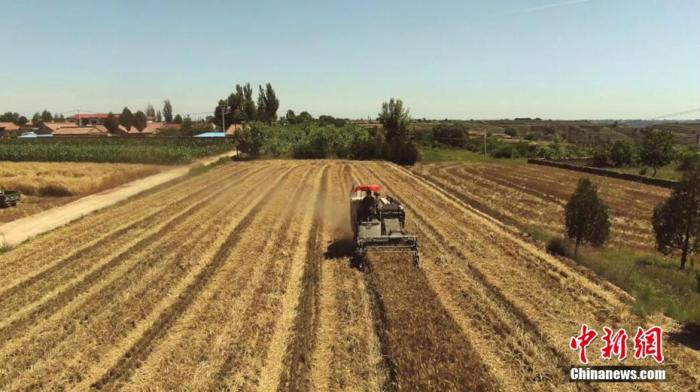China News Service, November 4th. In response to the possible impact of La Niña on agricultural production, Liu Lihua, deputy director of the Planting Management Department of the Ministry of Agriculture and Rural Affairs, said on the 4th that he would focus on the worst and make the most adequate preparations to fight against disasters and win a bumper harvest. , To take effective measures to effectively reduce the impact and losses of the disaster, to ensure the safe overwintering of winter wheat, and the stable supply of vegetables and other "vegetable basket" products.
Data map: Farmers use harvesters to harvest wheat.
Photo by Zong Ying
At the press conference of the Ministry of Agriculture and Rural Affairs held on the afternoon of the 4th, a reporter asked: We have noticed that according to the prediction of the National Climate Center, the La Niña incident will occur this winter. What disaster prevention and mitigation plans and measures will be adopted to deal with and reduce the impact of low temperature, rain, snow, and windy weather?
Liu Lihua responded that La Niña is a climatic phenomenon. It is mainly caused by the continuous abnormally low sea temperature in the equatorial Central and Eastern Pacific. From the judgment standard, it has entered the La Niña state if it is 0.5 degrees Celsius for three consecutive months. If the month is low, a La Nina event will be formed, which will have a more important impact on the weather and climate.
From a historical point of view, in La Niña years, the probability of a cold winter in my country is relatively high. For example, since 1951, there have been 15 La Niña events, of which 10 winters in our country were low in temperature, and 5 were high and cold. The probability is about twice that of warmer. For example, the moderate-intensity La Niña in 2008 caused the rare rain, snow and freezing disasters in the south.
Liu Lihua pointed out that from the weather monitoring situation, our country has now formed a La Niña state.
It is expected that a weak to moderate La Niña event will be formed in December.
Recently, we have also discussed with the China Meteorological Administration on the impact of the La Niña incident on agricultural production. It is expected that the overall temperature this winter will be warm before and then cold, with relatively large fluctuations in the temperature range.
There will be a periodical cooling from November to December, but the temperature in most areas is still generally normal, which is conducive to the winter wheat area to seize the last window period to rush to plant winter wheat, and to grasp the pre-winter management, promote the growth and development of wheat, and maintain a stable and stable area. Ensure safe overwintering.
Weather conditions are also conducive to the production of northern facility vegetables and southern open-field vegetables. It is expected that the amount of vegetables on the market will increase, which will help stabilize market prices.
Liu Lihua said that the meteorological department predicts that in the next winter, which is January and February of next year, the cold air will become stronger, and there may be periods of extreme cold waves.
However, according to expert analysis, the possibility of a large-scale rain, snow and freezing disaster similar to that in 2008 is still relatively small.
From the perspective of winter wheat production, the moisture content in the northern winter wheat region this year is the best year in recent years, which can effectively increase the heat capacity of the soil and improve the ability of wheat to resist cold and frost, but some weaker late sowing wheat may be Will be affected by some freezing damage.
Liu Lihua said that from the perspective of the production of vegetables and other "vegetable baskets", strong snowfall may affect the production of vegetables in local facilities, and low temperatures will also increase the risk of spreading animal diseases such as epidemic diarrhea in piglets. Snow disasters in pastoral areas will aggravate feeding. The difficulty of emergency forage supply has put pressure on the safe overwintering of livestock and poultry.
Regarding the possible impact of La Niña on agricultural production, Liu Lihua said that the Ministry of Agriculture and Rural Affairs will adhere to problem-oriented, bottom-line thinking, focus on the worst, make the most adequate preparations, and take effective measures to reduce the impact of disasters based on disaster prevention and harvest. And losses to ensure the safe overwintering of winter wheat and a stable supply of "vegetable basket" products such as vegetables.
Focus on four things:
The first is to pay close attention to weather changes, track and analyze the development of La Niña and its impact on agricultural production, formulate and implement response plans in a timely manner, and guide farmers to take targeted measures as early as possible, take the initiative to avoid disasters, and scientifically prevent disasters.
Second, in response to the complex situation of wheat seedlings this year, we will conduct a graded and classified survey of winter wheat seedlings, organize agricultural technicians to go to the front line, guide the implementation of field management measures before winter, and prevent low-temperature freezing and diseases, insects and weeds, and ensure the safe overwintering of wheat.
The third is to do a good job in providing guidance services for the production of vegetables. The Ministry has formulated technical guidelines for dealing with cold wave weather, implemented measures to prevent cold and frost, and stabilize vegetable production.
The fourth is to do a good job in the prevention and control of major animal diseases in winter, and instruct the pastoral areas to implement measures such as cold protection and warmth for livestock and poultry houses, and storage of overwintering forages, to minimize the impact of cold waves and ensure safe overwintering and normal production of livestock and poultry.

